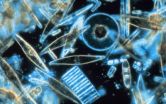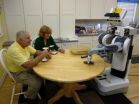(Press-News.org) (SACRAMENTO, Calif.) -- A team of UC Davis scientists has shown in experimental mouse models that a new drug delivery system allows for administration of three times the maximum tolerated dose of a standard drug therapy for advanced bladder cancer, leading to more effective cancer control without increasing toxicity.
The delivery system consists of specially designed nanoparticles that home in on tumor cells while carrying the anti-cancer drug paclitaxel. The same delivery system also was successfully used to carry a dye that lights up on imaging studies, making it potentially useful for diagnostic purposes. The findings are published today in the journal Nanomedicine.
"We have developed a novel, multifunctional nanotherapeutics platform that can selectively and efficiently deliver both diagnostic and therapeutic agents to bladder tumors," said Chong-Xian Pan, principal investigator of the study and associate professor of hematology and oncology at UC Davis. "Our results support its potential to be used for both diagnostic and therapeutic applications for advanced bladder cancer."
Cancer of the bladder usually develops in the cells of the inner lining of the bladder. Survival rates are high if the disease is caught early, but it remains difficult to treat in advanced stages ― when the tumor has grown outside of the bladder or metastasized to distant sites. It is the fourth most common cancer in men; it occurs less frequently in women.
Paclitaxel is a drug used to treat advanced bladder cancer and other cancers, but it is associated with serious safety concerns. It can be toxic to bone marrow, leading to reduced levels of red and white blood cells, putting patients at risk of infection. In addition, because the drug is not readily soluble in blood, it is typically dissolved in castor oil, which has caused severe ― and sometimes fatal ― allergic reactions.
The drug delivery system used in this study makes use of nanoparticles called micelles developed by Kit Lam, professor and chair of the UC Davis Department of Biochemistry and Molecular Medicine and a co-author of the article. Micelles are aggregates of soap-like molecules that naturally form a tiny spherical particle with a hollow center. The researchers incorporated specific targeting molecules ― called ligands ― into the micelle structure. These ligands, developed by UC Davis researchers, were successfully shown in earlier studies to preferentially bind to bladder cancer cells derived from dogs and humans.
In addition to the cancer-targeting ligands, the micelles were loaded with paclitaxel. Experiments were run on mice receiving different dosages of the drug: the standard dosage currently used for therapy, and another dosage three times that amount. Mice receiving the standard dosage had significantly less tumor growth and longer overall survival compared to control mice who received a saline solution instead of drug therapy. Mice that received the high dosage took the longest time to develop a tumor and had the most days of tumor control. They also had nearly three times longer survival than mice that received drug therapy in the conventional way ― without the use of the nanoparticle delivery system. The high dosage conferred few side effects and no deaths.
"The prognosis for advanced bladder cancer has not changed for three decades," said Pan. "Our findings have the potential to significantly improve outcomes."
Mice used in the experiments were specially injected with human bladder cancer cells obtained directly from patients with the disease. This technique is believed to make the study results more clinically relevant than the more common method of using cancer cell lines that have been maintained in laboratories for research purposes for long periods of time. According to the study authors, the transplanted tumors were highly aggressive cancers.
In other experiments, the researchers loaded the bladder-cancer-homing micelles with a fluorescent imaging dye instead of paclitaxel. The imaging results proved that the micelles were targeting the bladder cancer cells and indicated that the technique may have clinical applications for diagnosis and monitoring therapy.
"These research findings are extremely exciting on many levels," said Ralph deVere White, director of the UC Davis Comprehensive Cancer Center and a study author. "We have very promising results using a novel technology that may offer a new approach to treating a variety of very difficult-to-treat cancers. I look forward to seeing this approach move forward in clinical trials."
###
The article is titled, "Tumor-targeting multifunctional micelles for imaging and chemotherapy of advanced bladder cancer." The other study authors are Tzu-yin Lin, Yuan-Pei Li, Hongyong Zhang, Tingjuan Gao and Kit Lam, all of UC Davis; Juntao Luo of SUNY Upstate Medical University in Syracuse, New York; and Neal Goodwin of Jackson Laboratory in Sacramento.
This study was supported by the Veterans Administration Career Development Award-2, the National Cancer Institute Cancer Center Support Grant P30 (P30 CA093373) and the Cancer Clinical Investigator Team Leadership Award.
UC Davis Comprehensive Cancer Center is the only National Cancer Institute-designated center serving the Central Valley and inland Northern California, a region of more than 6 million people. Its specialists provide compassionate, comprehensive care for more than 9,000 adults and children every year, and access to more than 150 clinical trials at any given time. Its innovative research program engages more than 280 scientists at UC Davis, Lawrence Livermore National Laboratory and Jackson Laboratory (JAX West), whose scientific partnerships advance discovery of new tools to diagnose and treat cancer. Through the Cancer Care Network, UC Davis collaborates with a number of hospitals and clinical centers throughout the Central Valley and Northern California regions to offer the latest cancer care. Its community-based outreach and education programs address disparities in cancer outcomes across diverse populations. For more information, visit cancer.ucdavis.edu.
UC Davis researchers develop new drug delivery system for bladder cancer using nanoparticles
2012-10-26
ELSE PRESS RELEASES FROM THIS DATE:
New genomics study shows ancestry could help solve disease riddles
2012-10-26
LA JOLLA, CA – October 25, 2012 – Explosive advancement in human genome sequencing opens new possibilities for identifying the genetic roots of certain diseases and finding cures. However, so many variations among individual genomes exist that identifying mutations responsible for a specific disease has in many cases proven an insurmountable challenge. But now a new study by scientists at The Scripps Research Institute (TSRI), Scripps Health, and Scripps Translational Science Institute (STSI) reveals that by comparing the genomes of diseased patients with the genomes of ...
A 'nanoscale landscape' controls flow of surface electrons on a topological insulator
2012-10-26
CHESTNUT HILL, MA (October 25, 2012) – In the relatively new scientific frontier of topological insulators, theoretical and experimental physicists have been studying the surfaces of these unique materials for insights into the behavior of electrons that display some very un-electron-like properties.
In topological insulators, electrons can behave more like photons, or particles of light. The hitch is that unlike photons, electrons have a mass that normally plays a defining role in their behavior. In the world of quantum physics, where everyday materials take on surprising ...
Changing the balance of bacteria in drinking water to benefit consumers
2012-10-26
WASHINGTON, Oct. 25, 2012 — The latest episode in the American Chemical Society's (ACS') award-winning Global Challenges/Chemistry Solutions podcast series reports that scientists have discovered a plausible way to manipulate the populations of mostly beneficial microbes in "purified" drinking water to potentially benefit consumers.
Based on a report by Lutgarde Raskin, Ph.D., in ACS' journal Environmental Science & Technology, the new podcast is available without charge at iTunes and from www.acs.org/globalchallenges.
In the new episode, Raskin explains that municipal ...
Small marine organisms' big changes could affect world climate
2012-10-26
In the future, warmer waters could significantly change ocean distribution of populations of phytoplankton, tiny organisms that could have a major effect on climate change.
Reporting in this week's online journal Science Express, researchers show that by the end of the 21st century, warmer oceans will cause populations of these marine microorganisms to thrive near the poles and shrink in equatorial waters.
"In the tropical oceans, we are predicting a 40 percent drop in potential diversity, the number of strains of phytoplankton," says Mridul Thomas, a biologist at Michigan ...
Small organisms could dramatically impact world's climate
2012-10-26
EAST LANSING, Mich. — Warmer oceans in the future could significantly alter populations of phytoplankton, tiny organisms that could have a major impact on climate change.
In the current issue of Science Express, Michigan State University researchers show that by the end of the 21st century, warmer oceans will cause populations of these marine microorganisms to thrive near the poles and may shrink in equatorial waters. Since phytoplankton play a key role in the food chain and the world's cycles of carbon, nitrogen, phosphorous and other elements, a drastic drop could have ...
Individual gene differences can be tested in zebrafish
2012-10-26
HERSHEY, Pa. -- The zebrafish is a potential tool for testing one class of unique individual genetic differences found in humans, and may yield information helpful for the emerging field of personalized medicine, according to a team led by Penn State College of Medicine scientists. The differences, or mutations, in question create minor changes in amino acids -- the building blocks of DNA -- from person to person. Zebrafish can be used as a model to understand what biological effects result from these genetic mutations.
Personalized medicine uses modern technology and ...
Monster galaxy may have been stirred up by black-hole mischief
2012-10-26
Astronomers using the NASA/ESA Hubble Space Telescope have obtained a remarkable new view of a whopper of an elliptical galaxy, with a core bigger than any seen before. There are two intriguing explanations for the puffed up core, both related to the action of one or more black holes, and the researchers have not yet been able to determine which is correct.
Spanning a little over one million light-years, the galaxy is about ten times the diameter of the Milky Way galaxy. The bloated galaxy is a member of an unusual class of galaxies with an unusually diffuse core filled ...
Exercise boosts satisfaction with life, researchers find
2012-10-26
UNIVERSITY PARK, Pa. -- Had a bad day? Extending your normal exercise routine by a few minutes may be the solution, according to Penn State researchers, who found that people's satisfaction with life was higher on days when they exercised more than usual.
"We found that people's satisfaction with life was directly impacted by their daily physical activity," said Jaclyn Maher, graduate student in kinesiology. "The findings reinforce the idea that physical activity is a health behavior with important consequences for daily well-being and should be considered when developing ...
Robots in the home: Will older adults roll out the welcome mat?
2012-10-26
Robots have the potential to help older adults with daily activities that can become more challenging with age. But are people willing to use and accept the new technology? A study by the Georgia Institute of Technology indicates the answer is yes, unless the tasks involve personal care or social activities.
After showing adults (ages 65 to 93 years) a video of a robot's capabilities, researchers interviewed them about their willingness for assistance with 48 common household tasks. Participants generally preferred robotic help over human help for chores such as cleaning ...
New genes discovered for adult BMI levels
2012-10-26
A large international study has identified three new gene variants associated with body mass index (BMI) levels in adults. The scientific consortium, numbering approximately 200 researchers, performed a meta-analysis of 46 studies, covering gene data from nearly 109,000 adults, spanning four ethnic groups.
In discovering intriguing links to lipid-related diseases, type 2 diabetes and other disorders, the IBC 50K SNP Array BMI Consortium's study may provide fundamental insights into the biology of adult obesity. Scientists from the Center for Applied Genomics at The Children's ...



